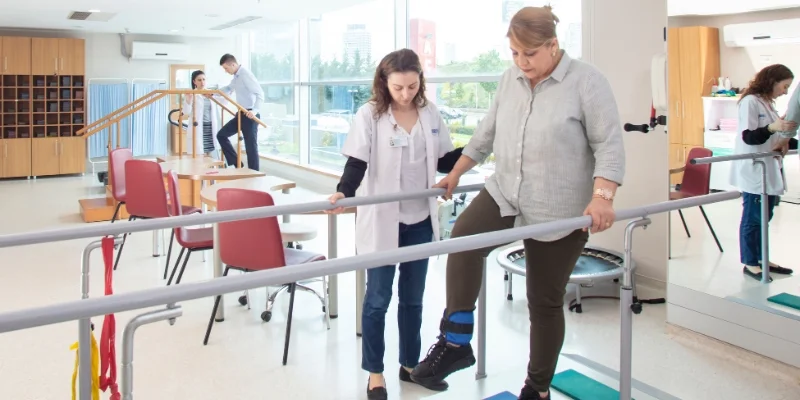Pain, in its various forms, is an undeniable aspect of the human experience. Whether acute or chronic, its impact on our physical and mental well-being cannot be understated.
As we navigate the intricacies of pain, it becomes essential to unravel its complexities and explore avenues for effective management. This comprehensive guide aims to shed light on the multifaceted concept of pain, its diverse origins, and the pivotal role of proper management in fostering a healthier, more resilient life.
At Core Physiotherapy & Exercise Centres, one of our primary objectives is to support you in understanding and dealing with the intricacies of your pain, so let’s unpack everything there is to know about this complex subject.
Understanding the Concept of Pain
Pain is a largely personal and subjective experience that comes in two parts: one involves a specific sensation in a particular part of the body, and the other is the unpleasant feeling often linked to actions taken to alleviate or stop the sensation.
Pain Australia outlines that pain, while extremely unpleasant, actually serves as a crucial element in our body’s protective mechanisms and thereby ensures our safety. The detectors for potential danger within the body relay information to the brain, where the experience of pain is determined based on a multitude of factors, including existing information and past encounters.
These detectors act as warning signals when tissues are nearing their safe thresholds, effectively preventing potential harm. If tissue damage occurs, these danger detectors heighten their sensitivity (1).
How Do We Perceive Pain?
The complexity of pain perception in the brain is significantly influenced by psychological, social factors, and previous experiences (1). When speaking purely about the neurological processes, however, there are several key elements to how our brain transmits information.
According to the Institute of Medicine (US) Committee on Pain, Disability, and Chronic Illness Behavior, we can think of pain a bit like our other senses in two core ways:
- Dedicated pain receptors: These are the nerve endings scattered in most body tissues, and they only kick into gear when there’s some kind of harm or potential harm on the horizon.
- Pain signals: The signals triggered by these not-so-friendly stimuli get sent through specific nerves to the spinal cord.
The nerve ending in the tissue and its partner nerve create what’s known as the primary afferent nociceptor duo. This duo connects with second-order pain-transmission neurons in the spinal cord.
These second-order cells then pass the message along well-defined pathways to higher brain centres. The higher brain centres include the brainstem reticular formation, thalamus, somatosensory cortex, and limbic system. It’s believed that the thalamus and cortex are the main players in the processes behind how we perceive pain (2).

Types of Pain
When we think of types of pain, the go-to response is likely chronic pain and acute pain. Chronic pain typically lasts longer than an expected healing time, generally over six months, whereas acute pain is short-lived and usually dissipates once the damaged tissue has healed (3). In reality, these terms are more accurate for describing the nature of pain, particularly how long it affects us.
Types of pain can be better categorised into two main areas: neuropathic pain and nociceptive pain. So, what are the differences?
Neuropathic Pain
Commonly known as nerve pain, neuropathic pain tends to be chronic and is associated with various conditions like diabetes, multiple sclerosis, stroke, cancer, cytomegalovirus, and amputation (among many other things, of course).
Neuropathic pain is essentially pain that results from nervous system damage or dysfunction. This is most commonly due to disease or injury and distinguishes itself from nociceptive pain by not arising in response to specific circumstances or external stimuli.
Remarkably, individuals can experience neuropathic pain even in the absence of the affected body part, as observed in phantom limb pain following amputations (4).
Nociceptive Pain
Nociceptive pain is typically acute and arises in response to specific situations, diminishing as the affected body part heals. Specialised nerve cells called nociceptors, detect potential harm, transmitting warning signals rapidly to the brain through the nervous system, resulting in nociceptive pain.
This quick process allows us to react promptly in unwanted situations. Think about a time when you’ve touched a hot pan, for example, and quickly removed your hand to run it under cold water. Another common example of nociceptive pain might be when you step on something sharp or hard, like a sneakily hiding piece of Lego on the floor. Your immediate response is to lift up your foot to remove yourself from the pain.
While internal organs also contain nociceptors, their alarm signals are less distinct and may not always be consciously perceived. The insights gained from nociceptive pain aid the body in safeguarding and promoting healing (4).

What Are the Common Causes of Pain?
We all experience some kind of pain now and then – minor injuries and accidents, delayed onset muscle soreness from intense workouts, and age-related aches and pains are all more or less par for the course. But what about more serious or chronic pain conditions?
According to the Australian Institute of Health and Welfare (AIHW), the most common causes of chronic pain are serious injuries, musculoskeletal conditions like arthritis, post-surgical circumstances or surgery complications, and other conditions like cancer and endometriosis. In some cases, however, chronic pain can have no physical causes.
While causes of acute pain are more readily understood as tissue damaged by circumstantial injuries or traumas, the underlying causes of chronic pain conditions are more complex.
Data from the AIHW’s 2020 report on chronic pain in Australia indicates that chronic pain might be caused by “damage to body tissue from an acute or chronic condition, or changes in the nerves or nervous system that result in the nerves continuing to signal pain after the original condition has healed” (5).
Exploring Pain Management Techniques
When looking at chronic pain management, it’s important to acknowledge that this type of pain extends beyond a physical sensation. Many factors also contribute to the severity of pain, like quality of sleep, exercise, overall health, attitudes, beliefs, mood, environment, and social interactions.
When we think of pain as being influenced by all these factors and more, we can start to explore numerous and diverse avenues for pain management (6). The core pain management strategies most commonly prescribed to adults include:
- Pain relief medicines
- Non-pharmacological tools and methods, like heat and cold packs and acupuncture
- Physical therapies, like physiotherapy and massage therapy
- Psychological therapy such as cognitive behavioural therapy
- Mindfulness and relaxation techniques, particularly breathing-focused sessions and meditation
- Community and social supports
Physical Therapy: Holistic Approach to Pain Relief
Outside of medication, Physiotherapy and exercise, can be an effective and much-needed avenue for chronic pain management. Physiotherapists in particular possess a wide variety of specialised skills and knowledge with which to treat and support people dealing with pain in many different forms.
Despite the positive outlook from a health practitioner perspective, along with ongoing progress in the field, recent research suggests that there is a common misgiving among patients when it comes to physical therapy for pain relief.
Many individuals reported that they expected a complete ‘cure’ for their pain through physical therapy. Others held fears that such therapy could in fact make their pain worse from an incorrectly applied hands-on approach (7) as they had experienced in the past, or from prescribed exercises and movement that hadn’t been properly planned or executed under guidance.
When approaching pain management and relief, it’s therefore crucial that we look at things from a holistic perspective. According to Pain Australia, holistic strategies that incorporate activity, psychological skills, and self-management can actually teach the pain system to become less protective, which reduces the strength of the neurotransmitters responsible for feeling pain (6).
Integrated Treatment
At Core Physiotherapy & Exercise Centres, our inclusive pain management services encompass a diverse range of strategies personalised to address your distinct needs and conditions.
Our integrated approach to pain management is rooted in understanding the intricacies of chronic pain and its impact on your physical, emotional, and mental well-being. Through a comprehensive assessment, our highly skilled team gains insights into your specific situation, enabling the creation of an individualised treatment plan that takes into account all aspects of your pain.
Our multidisciplinary team includes professionals from diverse fields, such as:
- Physiotherapy
- Exercise physiology
- Psychology
- Psychiatry
- Sports & Performance
By collaborating and integrating our expertise, we provide an integrated approach that combines evidence-based practices and innovative techniques to alleviate your pain and enhance your overall function.
Above all, we work with you to ensure your comfort and progress. Pain management can be extremely difficult, but it can also be wonderfully rewarding. It’s important to have a strong support network when dealing with chronic pain; at Core, that’s something we not only understand but also fully endorse.
Education, Mindfulness, and Relaxation for Pain Relief
Something we always like to impress upon our clients is the importance of education. Understanding what your type of pain is, where it is in the body, and what the underlying cause really means can be game-changers in your pain management journey.
Our team has a wealth of knowledge and resources available about many types of pain, so if you’re not sure where to start, simply get in touch with us. Pain education is often the first step in changing your mindset about pain, which is a major component in effective management.
After gaining a solid understanding of pain, the subsequent step involves addressing your mindset and attitudes towards pain. The normal mood and stress impact associated with persistent pain can become a notable barrier to effective pain management unless properly addressed.
Utilising relaxation and psychological techniques like mindfulness can empower you to actively take control of your natural thoughts concerning pain. This enables you to gradually increase daily activity levels, confident in your journey towards recovery.
Seeking guidance from a counsellor or psychologist can also be beneficial, especially when initially developing these skills (7).

Effective Chronic Pain Management
Ready to take control of your pain and improve your quality of life? Contact Core Physiotherapy & Exercise Centres today to schedule a thorough assessment and embark on a personalised pain management journey.
Our team of experts is committed to helping you alleviate pain, enhance function, and achieve lasting relief. Call us to book your appointment
Interested in learning more about pain and pain management? Check out our free eBook on how movement and other non-medical treatments can work wonders for ongoing pain relief.
Sources
- https://www.painaustralia.org.au/about-pain/painaustralia-common-forms-of-pain
- https://www.ncbi.nlm.nih.gov/books/NBK219252/
- https://www.aihw.gov.au/reports/chronic-disease/chronic-pain-in-australia/summary
- https://www.medicalnewstoday.com/articles/319895#what-is-nociceptive-pain
- www.aihw.gov.au/getmedia/10434b6f-2147-46ab-b654-a90f05592d35/aihw-phe-267.pdf?v=20230605184320&inline=true
- https://www.painaustralia.org.au/about-pain/painaustralia-what-is-pain
- https://corehealthcare.com.au/wp-content/uploads/2019/11/ITS-OK-TO-MOVE-Final.pdf


